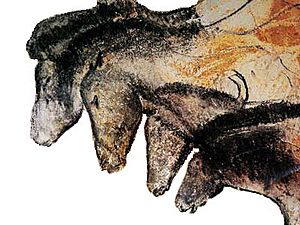Chauvet Cave facts for kids
The Chauvet Cave, also known as Chauvet-Pont-d'Arc Cave, is a famous cave in southern France. It's located near Vallon-Pont-d'Arc in the Ardèche area. This cave became very well-known in 1994. That's when amazing ancient artwork was found on its walls.
Inside the cave, people found traces of many animals. Some of these animals are now extinct, meaning they no longer exist. There were also footprints of both animals and humans. The Chauvet Cave is one of the most important prehistoric art sites in the world. It's as important as other famous caves like Lascaux, Altamira, and Cosquer Cave.
Contents
What Makes Chauvet Cave Special?
The Ardèche region has many gorges and caves. Many of these caves are important for their geological features or archaeological finds. The Chauvet Cave is special because it's very large. Its artwork is also incredibly well-preserved and of high quality.
Humans lived in the cave at two different times long ago. These periods are called the Aurignacian and the Gravettian. Most of the beautiful artwork you see in the cave comes from the earlier Aurignacian time. This was about 30,000 to 32,000 years ago.
The only signs left from the later Gravettian period are a child's footprints. There are also burnt remains of old campfires. You can also see carbon smoke stains from torches that lit up the cave. It seems no one had entered the cave after that child until it was found in 1994. The footprints are some of the oldest human footprints ever found. They are between 20,000 and 30,000 years old!
The floor of the cave is made of a soft material, almost like clay. You can see paw prints from cave bears. There are also large, rounded dips in the floor. Scientists believe these were the nests where the bears slept. Many fossilized bones have been found, including the skulls of cave bears. There's even the horned skull of an ibex.
Amazing Cave Paintings
There are hundreds of animal paintings in Chauvet Cave. At least 13 different species are shown. Some of these animals are rarely, or never, seen in other ice age paintings.
Besides common hunted animals like horses, cattle, and reindeer, the walls of Chauvet Cave are covered with predatory animals. These include lions, panthers, bears, owls, rhinos, and hyenas.
Most cave art doesn't show complete human figures. Chauvet Cave is similar, though there is one possible partial "Venus" figure. This might show the legs of a woman. A very unusual figure seems to have the lower body of a woman with the upper body of a bison.
There are also a few panels with red ochre hand prints. Some are hand stencils made by spitting pigment over hands pressed against the cave wall. Abstract markings, like lines and dots, are found throughout the cave. There are also two images that look a bit like butterflies, but their exact meaning is unknown.
This mix of subjects makes experts think these paintings had a special meaning. They might have been part of rituals, shamanistic practices, or had a magical purpose.
How the Artists Worked
The artists who created these unique paintings used special techniques. These are not often seen in other cave art. Many paintings seem to have been made after the walls were cleaned. The artists scraped away debris and rough spots. This left a smoother, lighter area for them to work on.
They also made the paintings look three-dimensional. They did this by cutting or etching around the outlines of some figures. This made the animals stand out more. It also allowed torch light to create shadows around the edges, making them seem to move.
How Old Are the Paintings?
The paintings in Chauvet Cave are the oldest known cave paintings. Scientists found this out by using radiocarbon dating. They tested black pigment from the drawings, torch marks, and the cave floors.
The dates fall into two main groups. One group is around 27,000 to 26,000 years ago. The other, older group is around 32,000 to 30,000 years ago. As of 1999, the earliest date found was 32,900 years ago.
However, some archaeologists have questioned these dates. They want to do more research to be sure.
Discovery of the Cave
The cave is named after Jean-Marie Chauvet. He discovered it on December 18, 1994, along with Christian Hillaire and Eliette Brunel-Deschamps. The researchers found that the cave had been untouched for 20,000 to 30,000 years. It was like stepping back in time!
See also
Images for kids
-
Image of steppe wisent (Bison priscus). Paintings in the Chauvet Cave on post stamp of Romania 2001
Error: no page names specified (help). In Spanish: Cueva de Chauvet para niños
In Spanish: Cueva de Chauvet para niños








